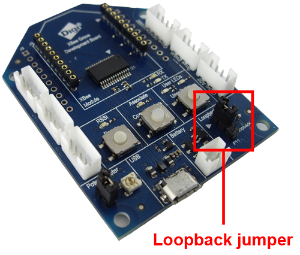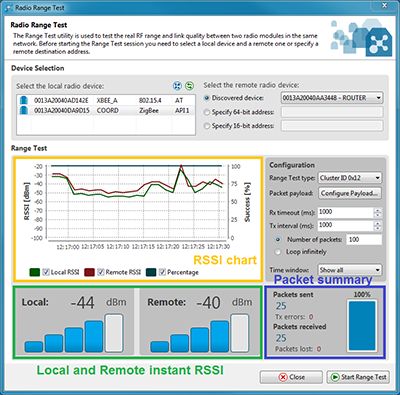Range test
Since the communication between XBee modules takes place over the air, the quality of the wireless signal can be affected by many factors: absorption, reflection of waves, line-of-sight issues, antenna style and location, etc.
A range test demonstrates the real-world RF range and link quality between two XBee modules in the same network. Performing a range test will give an initial indication of the expected communication performance of the kit components.
When deploying an actual network, multiple range tests are recommended to analyze varying conditions in your application.
XCTU allows you to perform a range test with at least one XBee module connected to your computer (local) and another remote XBee module, both in the same network. The range test involves sending data packets from the local XBee module to the remote and waiting for the echo to be sent from the remote to the local. During this process, XCTU counts the number of packets sent and received by the local module and measures the signal strength of both sides (RSSI):
- RSSI is the Received Signal Strength Indicator value.
- Every sent packet from the local XBee module should be received again as an echo by the same local XBee module.

There are two types of range tests:
- Loopback cluster (0x12): The range test is performed using explicit addressing frames/packets directed to the Cluster ID 0x12 on the data endpoint (0xE8) which returns the received data to the sender. Not all XBee variants support the Loopback Cluster. XCTU Range Test tool displays an error when this method is selected and the XBee module does not support it.
- Hardware loopback: The range test is performed using the serial port/USB hardware loopback capabilities. To use this type, the remote module must be configured to work in transparent mode and the loopback jumper must be closed before starting. This causes any received data to be transmitted back to the sender.

Note The local XBee module (the one attached to your computer) can be configured to use API or transparent mode. The RSSI value of the remote device can only be read when the local XBee module is working in API mode.
Once the range test process has started, XCTU represents the retrieved data in three ways:
- RSSI Chart represents the RSSI values of the local and remote devices during the range test session. The chart also contains the percentage of success for the total packets sent.
- Local and Remote instant RSSI value display the instant RSSI value of the local and remote devices. This value is retrieved for the last packet sent/received.
- Packet summary displays the total number of packets sent, packets received, transmission errors, and packets lost. It also displays the percentage of success sending and receiving packets during the range test session.

Note For more information about the range test tool, read the XCTU documentation.
 PDF
PDF


